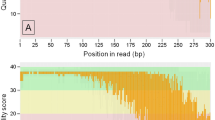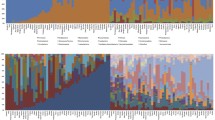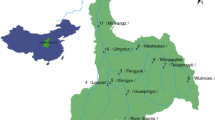Abstract
Amplicon sequencing approach is commonly employed in microbiome studies and sequencing depth is considered as a major factor influencing the outcome of data analyses. As of now, the effect of amplicon sequencing depth in environmental microbiome analyses is not explicitly illustrated. In this study, microbiome data of nine aquatic samples from Sundarbans mangrove region, obtained from SRA, were analyzed to explain the influence of sequencing depth variation in environmental microbiome data analyses. Briefly, four groups based on number of reads (NOR) were created comprising of, total NOR, 75 k, 50 k and 25 k, followed by data analyses. The results showed that the observed ASVs among four groups were significantly different (P value 1.094e−06). The Bray–Curtis dissimilarity analysis showed differences in microbiome composition and also, each group exhibited slightly different core-microbiome structure. Importantly, the variation in sequencing depth was found to affect the predictions of environmental drivers associated with microbiome composition. Thus, this study emphasizes that the microbiome data are compositional and the NOR in the data could affect the microbial composition. In summary, this study demonstrates the consequences of sequencing depth variation on microbiome data analyses and suggests the researchers to take proper cautions to avoid misleading results due to sequencing depth variation.





Similar content being viewed by others
References
McKenney EA, Koelle K, Dunn RR, Yoder AD (2018) The ecosystem services of animal microbiomes. Mol Ecol 27:2164–2172. https://doi.org/10.1111/mec.14532
Delgado-Baquerizo M, Oliverio AM, Brewer TE, Benavent-Gonzalez A, Eldridge DJ, Bardgett RD, Maestre FT, Singh BK, Fierer N (2018) A global atlas of the dominant bacteria found in soil. Science 359:320–325. https://doi.org/10.1126/science.aap9516
Hannula SE, Ma HK, Perez-Jaramillo JE, Pineda A, Bezemer TM (2020) Structure and ecological function of the soil microbiome affecting plant-soil feedbacks in the presence of a soil-borne pathogen. Environ Microbiol 22:660–676. https://doi.org/10.1111/1462-2920.14882
Pollock J, Glendinning L, Wisedchanwet T, Watson M (2018) The madness of microbiome: attempting to find consensus “best practice” for 16s microbiome studies. Appl Environ Microbiol. https://doi.org/10.1128/AEM.02627-17
Gloor GB, Macklaim JM, Pawlowsky-Glahn V, Egozcue JJ (2017) Microbiome datasets are compositional: and this is not optional. Front Microbiol 8:2224. https://doi.org/10.3389/fmicb.2017.02224
Pereira-Marques J, Hout A, Ferreira RM, Weber M, Pinto-Ribeiro I, van Doorn LJ, Knetsch CW, Figueiredo C (2019) Impact of host DNA and sequencing depth on the taxonomic resolution of whole metagenome sequencing for microbiome analysis. Front Microbiol 10:1277. https://doi.org/10.3389/fmicb.2019.01277
Pollock J, Glendinning L, Wisedchanwet T, Watson M, Liu S-J (2018) The madness of microbiome: attempting to find consensus “best practice” for 16s microbiome studies. Appl Environ Microbiol. https://doi.org/10.1128/aem.02627-17
Rajan SK, Lindqvist M, Brummer RJ, Schoultz I, Repsilber D (2019) Phylogenetic microbiota profiling in fecal samples depends on combination of sequencing depth and choice of NGS analysis method. PLoS ONE 14:e0222171. https://doi.org/10.1371/journal.pone.0222171
Zaheer R, Noyes N, Ortega Polo R, Cook SR, Marinier E, Van Domselaar G, Belk KE, Morley PS, McAllister TA (2018) Impact of sequencing depth on the characterization of the microbiome and resistome. Sci Rep 8:5890. https://doi.org/10.1038/s41598-018-24280-8
Gweon HS, Shaw LP, Swann J, De Maio N, AbuOun M, Niehus R, Hubbard ATM, Bowes MJ, Bailey MJ, Peto TEA, Hoosdally SJ, Walker AS, Sebra RP, Crook DW, Anjum MF, Read DS, Stoesser N, Consortium. obotR (2019) The impact of sequencing depth on the inferred taxonomic composition and AMR gene content of metagenomic samples. Environ Microbiome 14:7
Dhal PK, Kopprio GA, Gardes A (2020) Insights on aquatic microbiome of the Indian Sundarbans mangrove areas. PLoS ONE 15:e0221543. https://doi.org/10.1371/journal.pone.0221543
Callahan BJ, McMurdie PJ, Rosen MJ, Han AW, Johnson AJ, Holmes SP (2016) DADA2: High-resolution sample inference from Illumina amplicon data. Nat Methods 13:581–583. https://doi.org/10.1038/nmeth.3869
McMurdie PJ, Holmes S (2013) phyloseq: an R package for reproducible interactive analysis and graphics of microbiome census data. PLoS ONE 8:e61217. https://doi.org/10.1371/journal.pone.0061217
Murali A, Bhargava A, Wright ES (2018) IDTAXA: a novel approach for accurate taxonomic classification of microbiome sequences. Microbiome 6:140. https://doi.org/10.1186/s40168-018-0521-5
Wickham H (2016) ggplot2: elegant graphics for data analysis. Springer-Verlag, New York
Oksanen J, Balanchet FG, Friendly M, Kindt R, Legendre P, McGlinn D, Minchin PR, O'Hara RB, Simpson GL, Solymos P, Stevens MHH, Szoecs E, Wagner H (2019) vegan: Community Ecology Pacakage. R Pacakage version 2.5–6. https://cran.r-project.org/package=vegan
Caruso V, Song X, Asquith M, Karstens L (2019) Performance of microbiome sequence inference methods in environments with varying biomass. mSystems. https://doi.org/10.1128/mSystems.00163-18
Mas-Lloret J, Obón-Santacana M, Ibáñez-Sanz G, Guinó E, Pato ML, Rodriguez-Moranta F, Mata A, García-Rodríguez A, Moreno V, Pimenoff VN (2020) Gut microbiome diversity detected by high-coverage 16S and shotgun sequencing of paired stool and colon sample. Sci Data. https://doi.org/10.1038/s41597-020-0427-5
Acknowledgements
I would like to thank Dr. Bhawna Dubey, Scientist, GeneTech Pvt. Ltd., Hyderabad for reviewing the manuscript. The efforts of Dr. Dhal, Jadavpur University for making the data publicly available on SRA is highly appreciated. CSIR-NEERI is acknowledged for providing the necessary support to carry out the analyses.
Author information
Authors and Affiliations
Corresponding author
Additional information
Publisher's Note
Springer Nature remains neutral with regard to jurisdictional claims in published maps and institutional affiliations.
Supplementary Information
Below is the link to the electronic supplementary material.
Rights and permissions
About this article
Cite this article
Ramakodi, M.P. Effect of Amplicon Sequencing Depth in Environmental Microbiome Research. Curr Microbiol 78, 1026–1033 (2021). https://doi.org/10.1007/s00284-021-02345-8
Received:
Accepted:
Published:
Issue Date:
DOI: https://doi.org/10.1007/s00284-021-02345-8




